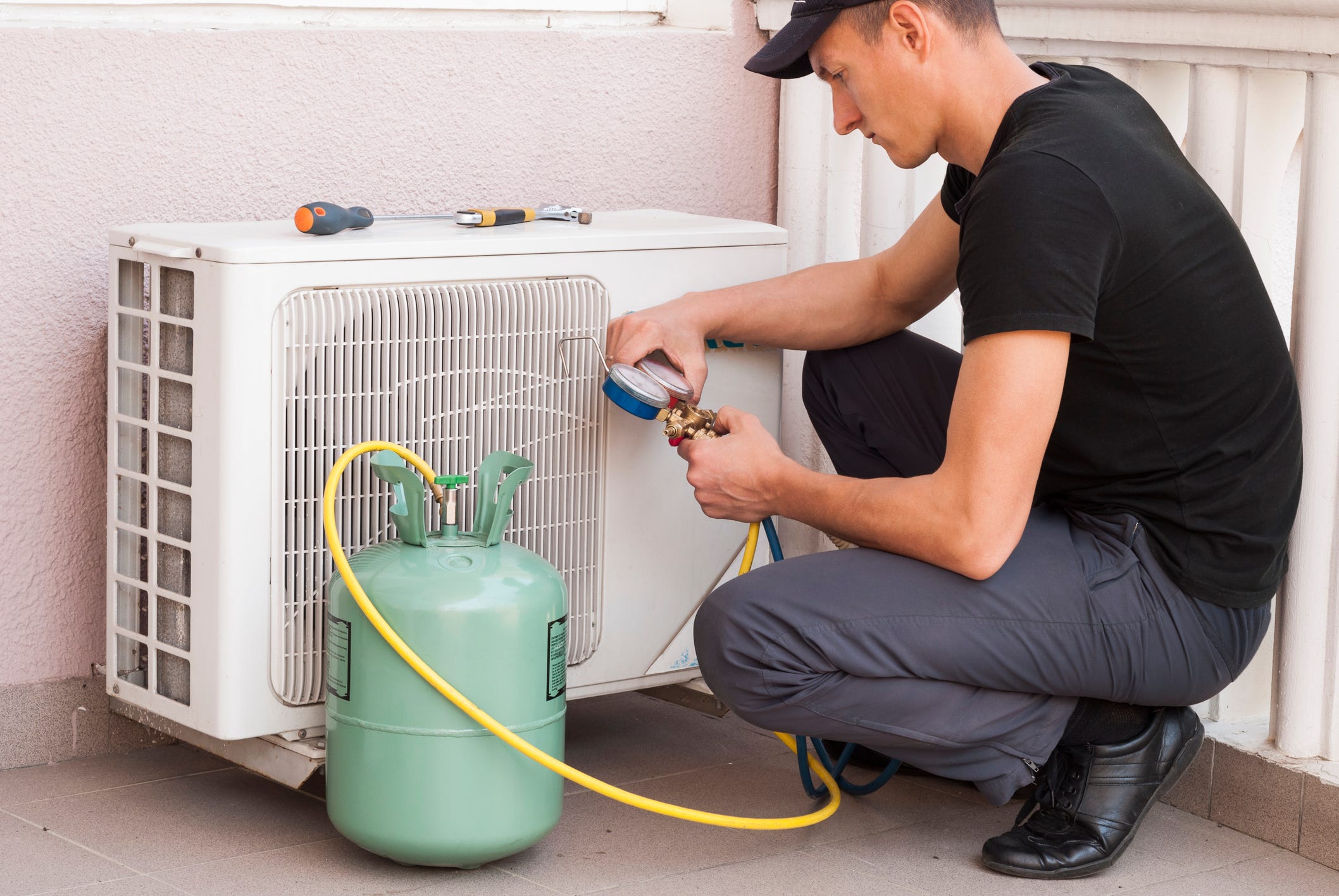Like all the necessary amenities, air conditioners have become an inseparable part of everyone’s lifestyle. Be it home, office, school, or meetings, air conditioners find their use everywhere. Adequate knowledge of the system is thus mandatory to keep it functioning.
Refrigerant pressure readings measured at the air conditioning compressor or the condenser units found on high or low-pressure sides are disturbing. This can point out a problem with the ability of the compressor to develop normal operating pressure ranges. The cooling capacity of the air conditioning system gets affected by henceforth.
Before knowing about the high-side compressor pressure and low-side compressor pressure of the air conditioner that is being used, there are few more requisites to attain first. One must know if the refrigerant R22 is being used, followed by its properties and alternatives.
How to Figure Out the Air Conditioner Refrigerant?

If the air conditioning system was purchased before 2010, then it is more likely to have an R22 refrigerant. Further information on the manufacture can be obtained from the template at the appliance outdoor condenser or on the service manual.
The cold air coming out from the air conditioners is due to a chemical called R22 refrigerant or Freon. The Environment Protection Agency (EPA) recognizes it as HCFC-22 (hydrochlorofluorocarbon).
Properties of an R22 refrigerant:
- The boiling point is -40.8 ℃ at atmospheric pressure (sea level).
- The density is 3.66 g/cm3.
- Colorless gas.
- Molar mass is 86.47 g/mol.
- R22 gauge pressure is 10.9 bar or 158.2 psi.
- High side pressure typically varies by equipment and metering controls.
- Low pressure or suction side typically varies by equipment.
- Low-pressure refrigerant turns on the carrier HVACR at 50 psi (R22 pressure at 30 degrees) and closes at 100 psi (R22 pressure at 85 degrees).
- R22 pressure at 85 degrees shows a vapor pressure of around 170 psi at the sea level.
- On the low-side R22 pressure at 85 degrees displays 60 psi, whereas on the high-side R22 pressure at 85 degrees shows 250 psi.
For servicing of the compressors, the right way is to follow the service manual. Service manuals are provided with the charging charts with details on the targeted suction vacuum pressure (negative) and the output pressure of the compressor motor.
High-Side Output Pressure in Air Compressor Conditioner:
For high-side output pressure, using R22 pressure at 85 degrees is called for 120 degrees.
In case of using R22 inside, or at the ambient room temperature, add 35 degrees to the incoming air temperature. An output high-side compressor pressure of about 260 psi is used.
High-side Air Conditioner Compressor Pressure
- The output or high-side air conditioner compressor motor pressure involves the return of the refrigerant gas, through the suction line, to the compressor.
- The job of the compressor motor is to compress the low-pressure refrigerant to a high-pressure one. This gas is then condensed, in the condensing unit, into a refrigerant liquid before being returned to the air handler.
- The compressor, condensing coil, and fan find their utilities in cooling the condensing coil outside the refrigerated space. It is immersed in the air at room temperature. Heat flows from hotter space to a more relaxed space, and the same applies here as well.
Low-Side Input or Suction Line Pressure in Air Compressor Conditioner:
For low-side output pressure, using R22 pressure at 85 degrees is called for 45 degrees of the same compressor model.
In case of using R22 inside, or at the ambient room temperature, subtract 45 degrees from the incoming air temperature. The service chart indicates that the suction line pressure to be used is about 75 psi.
With a temperature correction chart, one can gain the basic knowledge of the refrigerant pressure for any refrigerant gas and also the actual ambient temperature.
Reminder: The pressure test gauges measure the refrigerant pressure in the static or equalized air conditioning or heat pump system. It gives awareness only about the refrigerant pressure and not the amount of the refrigerant gas present in the system.
Service manuals of air conditioners explain the low-side and high-side air conditioner compressor motor pressure:
Low-Side Air Conditioner Compressor Pressure:
- One can spot the low-side of an air conditioning system inside an air handler. The air handler functions to pass air through the area that is to be cooled.
- The low-side air conditioner compressor motor pressure involves the suction line (low side pressure during compressor operation), which has a comparatively low value, as the name indicates, less than 100 psi.
- The refrigerant gas like R22 is returned from the cooling coil, the evaporator, to the compressor in the line. This can be tested by connecting the suction line to a sealed vacuum test gauge on the same line.
- Once the pressure of the cooling coil is reduced, the compressor allows the liquid refrigerant to be discharged into the cooling coil to obtain an optimum temperature.
There are many options available to choose from the amazon, some of which have been enlisted below:
1. Frigidaire White Energy Star Window Air Conditioner
The Frigidaire 1.5 ton 3-star window AC is suitable for medium-sized rooms. It is economical and easy to install. It has gained more than 700 ratings overall, out of which 49% of the happy customers have given a five-star. The condenser coil is made of copper. This air conditioner with R22 pressure at 85 degrees has ensured its best quality for the money spent on it.
Features:
- R22/R32 refrigerant gas
- Anti-bacterial filter
- Dust filter
- De-humidifier system.
- Economical
- Less energy consumption
- Low maintenance
- Better cooling
Based on the survey, the Voltas 1.5 ton 3-star window AC scores a 3.9 over 5 with a price tag of just $362, giving a 1-year limited warranty on the condenser and five years on the compressor.
No products found.
2. Pioneer Air Conditioner Inverter Split Air Conditioner
The Pioneer Air Conditioner inverter split AC comes with an inverter compressor and is suitable for medium-sized rooms. The indoor unit dimensions are 957x302x213, while the outdoor unit dimensions are 720x495x270. It is environmentally-friendly; thus, does not affect global warming. It has gained more than 1000 ratings overall, out of which 48% of the happy customers have given a five-star.
Features:
- Variable speed compressor
- Adjusts with power depending on heat load.
- Anti-bacterial filter
- Dust filter
- The most energy-efficiency – 3 star
- ISEER value is 3.8
- The power supply is 230 Volts or 50 Hertz.
- Lowest noise operation system.
- Low maintenance
- Better cooling
Based on the survey, the Voltas 1.5 ton 3-star inverter split AC scores a 3.8 over 5 with a price tag of just $432, giving a 1-year limited warranty on the condenser and five years on the compressor.
No products found.
3. Klimaire Inverter Split Air Conditioner
The Godrej 1 ton 3-star inverter split AC is suitable for medium-sized rooms. It is economical and easy to install. It has gained 137 ratings overall, out of which 45% of the happy customers have given a five-star.
Features:
- Anti-corrosive coating layer
- Anti-bacterial condenser
- Anti-bacterial evaporator
- Self-cleaning system
- The power supply is 230 Volts or 50 Hertz
- The maximum ambient temperature for cooling is 50 degrees Celsius.
- Variable speed compressor
- Auto adjustment of power supply depending on the heat load.
- Less energy consumption
- Lowest noise operation system
Based on the survey, the Godrej 1 ton 3-star inverter split AC scores a 3.9 over 5 with a price tag of just $368, giving a 1-year warranty on the condenser and ten years on the compressor.
No products found.
Please note that even when the compressor is not running, there is still pressure in the heat pump system. When the motor remains off for a certain period, pressure in the whole system equalizes the refrigerant low-pressure number so that it can stay close to the outdoor or the room temperature. It is observed that R22 pressure at 85 degrees settles at 143.7 psi, while for the other system, like R410, the pressure at 85 degrees is 235.9 psi.
A Check On The Environment:
If the air conditioner has already served for more than a decade, then it is time to buy an upgraded air conditioner, which is also a more environmentally-friendly system. Sticking with the old refrigerant system like R22 pressure only means spending more for nothing.
EPA monitors the use of hazardous chemicals that have the potential to affect the environment. R22 refrigerant is a chemical which depletes the ozone layer. Thus EPA regulates the manufacture and utility of R22 refrigerant, but not the system altogether. When the air conditioning unit is out of order, R22 refrigerant can be replaced by R410a units. It is a revised version following the regulations of EPA.
One can also call the technical team expert or the customer care service of the air conditioner to repair and/or replace the parts of the air conditioner to make it compatible with an approved refrigerant. The experts make the purchase easy from HVAC manufacturers. The energy costs and power supply can be lowered with better finance options delivered from the experts.

